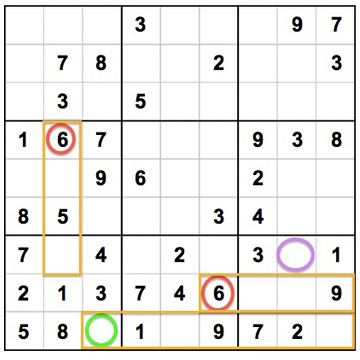How to Solve Sudoku Puzzles by Thinking Ahead

Sometimes you can anticipate which numbers are going to go in which spaces before you’ve even placed them. This is part of the fun and “addictive” aspect of Sudoku – the game develops a mental momentum where you can feel the numbers falling into place.
If you can figure out a general idea of where a number goes within a square, row or column (even if you can’t specify the exact space), you can “think ahead” and rule out a row or column of an adjacent square. Sometimes you can solve puzzles more quickly this way, even if you don’t know exactly where all the numbers go – if you have a general idea, you can build on that to use process of elimination in other parts of the grid.
Here is a real example and explanation of solving Sudoku puzzles by “thinking ahead.”
In the screenshot shown below, the bottom left square has only two empty spaces, and we know based on the numbers that are already visible that the two remaining numbers are 6 and 9. Looking to the square above – the left center square – we see a number 6 in the center column (circled in red).

That means the top center space of the lower left square CANNOT contain number 6 (outlined in orange). This means that by process of elimination, the number 6 must be placed in the lower right space of the lower left square (circled in green).
Now, we’ve solved the lower left square – but this also gives us an opportunity to continue our momentum by “thinking two steps ahead” and seeing how the grid changes now that we know the identity of that empty space. Since the lower right corner space of the lower left square (circled in green) will contain a 6, we know that the entire bottom row cannot contain a 6 anywhere else. We have outlined all of the spaces in orange (most of the bottom row) to show which spaces are affected by this.
Also, we can see that there is a 6 in the lower center square (circled in red), which means that the two empty spaces of the center row of the lower right square also cannot contain a 6 (outlined in orange). This shows us that there is only one space remaining in the lower right square that can contain a 6 (circled in purple), and by process of elimination, this is where the 6 must be placed in that lower right square.
In this way, we can “think ahead” to take one Sudoku move and immediately use it to create additional number placements. This kind of “speed reading” of the Sudoku grid helps create faster and more efficient Sudoku puzzle solving. Over time, you’ll learn to develop your own sense of momentum to anticipate which numbers go where, and which numbers come next, and which areas of the Sudoku grid to search for the next opportunity. All of this sense of “mental momentum” and anticipation, the sense of the puzzle “falling into place” in an orderly manner, is part of what makes Sudoku such a fun and popular logic puzzle game.